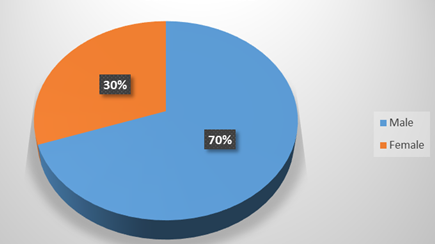Clinical outcome and risk factors of patients with acute myocardial infarction: A tertiary level hospital-based study in Bangladesh.
Abstract
Introduction: Coronary Artery Disease (CAD) remains the major cause of mortality and morbidity in mankind. Even though a lot of advances are made in the diagnosis, management, and prevention of the disease. Coronary Artery Disease (CAD) is the leading cause of death in the United States, affecting over 5 million Americans. It is the most common cause of death worldwide.
Aim of the study: The study aimed to evaluate the clinical outcome and Risk Factors of Patients with Acute Myocardial Infarction in a Tertiary Level Hospital-Based Study in Bangladesh.
Methods: This cross-sectional study was conducted in the Department of Cardiology, TMC & RCH, Bogura, Bangladesh from January 2020 to January 2021. The study was conducted after obtaining ethical clearance from the institutional review board of TMC & RCH, Bogura, Bangladesh. The data was collected from the discharge records of the patients admitted to the cardiology department.
Result: A total of 56 patients were diagnosed with myocardial infarction and analyzed in this study. The age distribution of the study was based on STEMI, 22(39.39%) patients suffering from AMI were in the 50-59 years age group, 16(28.57%) patients were from the age group 60-69, 12(21.43%) patients were from the age group 40-49, among the 5(8.93%) patients were from the age group >70 age group and only one patient was from the age group 30-39. the clinical outcomes of the study population; there are 17(30.36%) patients who had a cardiogenic shock, 13(23.21%) patients who were getting well, 12(21.43%) patients who had LVF/Pulmonary edema, 7(12.50%) patients had bradyarrhythmias and both 7(12.50%) patients died within 24 hours of hospital admission, 5(8.93%) patients have had tachyarrhythmias, 4(7.14%) patients had a cardiac arrest and only one patient had a mechanical complication.
Conclusion: There is a need for early detection of risk factors to prevent the progression of coronary heart disease, a need for creating awareness in the community regarding risk factors, symptoms, and signs of acute myocardial infarction so that early referral can be done to the coronary care unit to prevent morbidity and mortality in the community.
Downloads
References
World Health Organization. Fact sheet: Cardiovascular diseases (CVDs). 2017. Available at http://www.who.int/mediacentre/factsheets/fs317/en / Accessed 12 November 2017.
Finegold JA, Asaria P, Francis DP. Mortality from ischaemic heart disease by country, region, and age: statistics from World Health Organisation and United Nations. Int J Cardiol. 2013;168(2):934-45.
Yusuf S, Reddy S, Ôunpuu S, Anand S. Global burden of cardiovascular diseases Part I: general considerations, the epidemiologic transition, risk factors, and impact of urbanization. Circ. 2001;104(22):2746-53.
Reddy KS. Cardiovascular diseases in the developing countries: dimensions, determinants, dynamics and directions for public health action. Pub Health Nutr. 2002;5(1A):231-7.
Reddy KS. Cardiovascular disease in non-western countries. New Eng J Med. 2004;350(24):2438-40.
Joshi P, Islam S, Pais P, Reddy S, Dorairaj P, Kazmi K, et al. Risk factors for early myocardial infarction in South Asians compared with individuals in other countries. J Am Med Assoc. 2007;297(3):286-94.
Mendis S, Thygesen K, Kuulasmaa K, Giampoli S, Mähönen M, Blackett KN, et al. World Health Organization definition of myocardial infarction: 2008-09 revision. Int J Epidemiol. 2011;40(1):139- 46.
Kosuge, M kimura k, Ishikawa T. Differences between men and women in terms of Clinical features of ST-segment elevation acute myocardial infarction. Circulation Journal.1999;12:222-226.
Sung, Ruey J, Michael R. Lauer. Fundamental Approaches to the management of Cardiac Arrhythmia. 2000; 13:322-23.
Josephson, Mark E. Clinical Cardiac Electrophysiology: techniques and interpretations. 2002; 10:200-11.
Singh PS, Singh G, Singh SK. Clinical profile and risk factors in acute coronary syndrome. J Ind Acad Clin Med. 2013;14(2):130-2.
Hafeez S, Javed A, Kayani AM. Clinical profile of patients presenting with acute ST-elevation myocardial infarction. J Pak Med Assoc. 2010;60(3):190-3.
El-Menyar A, Zubaid M, Shehab A, Bulbanat B, AlMotarreb A, Suwaidi JA. Prevalence and impact of cardiovascular risk factors among patients presenting with the acute coronary syndrome in the Middle East. Clin Cardiol. 2011;34(1):51-8.
Mendelsohn ME, Karas RH. The protective effects of estrogen on the cardiovascular system. New Eng J Med. 1999;340(23):1801-11.
Xavier D, Pais P, Devereaux PJ, Xie C, Prabhakaran D, Reddy KS, et al. Treatment and outcomes of acute coronary syndromes in India (CREATE): a prospective analysis of registry data. Lancet. 2008;371(9622):1435-42.
Sanchis-Gomar F, Perez-Quilis C, Leischik R, Lucia A. Epidemiology of coronary heart disease and acute coronary syndrome. Ann Translational Med. 2016;4(13):256-7.
Yusuf S, Hawken S, Ôunpuu S, Dans T, Avezum A, Lanas F, et al. Effect of potentially modifiable risk factors associated with myocardial infarction in 52 countries (the INTERHEART study): case-control study. Lancet. 2004;364(9438):937-52.
Rosengren A, Wallentin L, Simoons M, Gitt AK, Behar S, Battler A, et al. Cardiovascular risk factors and clinical presentation in acute coronary syndromes. Heart. 2005;91(9):1141-7.
Ambrose JA, Barua RS. The pathophysiology of cigarette smoking and cardiovascular disease: an update. J Am Coll Cardiol. 2004;43(10):1731-7
Woods KL, Samanta A, Burden AC. Diabetes mellitus is a risk factor for myocardial infarction in Asians and Europeans. Heart. 1989;62(2):118-22.
Kannel WB, McGee DL. Diabetes and cardiovascular risk factors: The Framingham study. Circ. 1979;59(1):8-13.
Jacoby RM, Nesto RW. Acute myocardial infarction in the diabetic patient: pathophysiology, clinical course, and prognosis. J Am Coll Cardiol. 1992;20(3):736-44.
Kennedy HL, Goldberg RJ, Szklo M, Tonascia JA. The prognosis of anterior myocardial infarction revisited: a community-wide study. Clin Cardiol. 1979;2(6):455-60.
Stone PH, Raabe DS, Jaffe AS, Gustafson N, Muller JE, Turi ZG, et al. Prognostic significance of location and type of myocardial infarction: independent adverse outcome associated with the anterior location. J Am Coll Cardiol. 1988;11(3):453-6.



























